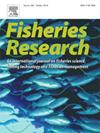Current status of native crayfish populations in Russia: A brief review of their biology and fisheries
IF 2.2
2区 农林科学
Q2 FISHERIES
引用次数: 0
Abstract
Historically, Russia has been a leader in the production of freshwater crayfish, with annual exports reaching 2000 t. However, the spread of crayfish plague led to a sharp decline in population densities in the 1970s. In this review, we provide an update on the current status of native crayfish populations in Russia, focusing on their biology and fisheries. The noble crayfish Astacus astacus primarily occur in the northwestern and central regions of Russia, whereas the narrow-clawed crayfish Pontastacus spp. are predominant in the Volga River basin and southern regions. The thick-clawed crayfish inhabits lagoons and estuaries in the Caspian Sea, Sea of Azov, and Black Sea. Between 2012 and 2015, annual catches fluctuated significantly. However, in the following four years, these figures stabilized, with a noticeable upward trend from 2020 onwards. A significant proportion of the total crayfish supply came from reservoirs, with an average contribution of 46 %. In addition, lakes, rivers, and other water bodies collectively contributed average share of 54 %. The Volgograd Reservoir, the Saratov Reservoir, water bodies along the left bank of the Volga River, and the Kuibyshev Reservoir are particularly important in terms of crayfish abundance and production accounting for 79 % of the total crayfish stock. The observed fluctuations in crayfish abundance are mainly due to environmental factors. The fisheries sector faces major challenges, including illegal fishing and habitat degradation.
俄罗斯本地小龙虾种群的现状:其生物学和渔业的简要回顾
历史上,俄罗斯一直是淡水小龙虾生产的领导者,年出口量达到2000只 吨。然而,小龙虾瘟疫的蔓延导致了小龙虾种群密度在20世纪70年代急剧下降。本文综述了俄罗斯本地小龙虾种群的现状,重点介绍了它们的生物学和渔业。高贵小龙虾Astacus Astacus主要分布在俄罗斯西北部和中部地区,而窄爪小龙虾Pontastacus spp.主要分布在伏尔加河流域和南部地区。这种厚爪小龙虾生活在里海、亚速海和黑海的泻湖和河口。2012年至2015年间,年捕获量波动很大。然而,在接下来的四年里,这些数字稳定下来,从2020年开始有明显的上升趋势。小龙虾供应总量的很大一部分来自水库,平均贡献为46% %。此外,湖泊、河流和其他水体共同贡献的平均份额为54% %。伏尔加格勒水库、萨拉托夫水库、伏尔加河左岸的水体和古比雪夫水库在小龙虾的丰度和产量方面尤其重要,占小龙虾总存量的79% %。观察到的小龙虾丰度波动主要是由环境因素引起的。渔业部门面临着重大挑战,包括非法捕鱼和栖息地退化。
本文章由计算机程序翻译,如有差异,请以英文原文为准。
求助全文
约1分钟内获得全文
求助全文
来源期刊

Fisheries Research
农林科学-渔业
CiteScore
4.50
自引率
16.70%
发文量
294
审稿时长
15 weeks
期刊介绍:
This journal provides an international forum for the publication of papers in the areas of fisheries science, fishing technology, fisheries management and relevant socio-economics. The scope covers fisheries in salt, brackish and freshwater systems, and all aspects of associated ecology, environmental aspects of fisheries, and economics. Both theoretical and practical papers are acceptable, including laboratory and field experimental studies relevant to fisheries. Papers on the conservation of exploitable living resources are welcome. Review and Viewpoint articles are also published. As the specified areas inevitably impinge on and interrelate with each other, the approach of the journal is multidisciplinary, and authors are encouraged to emphasise the relevance of their own work to that of other disciplines. The journal is intended for fisheries scientists, biological oceanographers, gear technologists, economists, managers, administrators, policy makers and legislators.
 求助内容:
求助内容: 应助结果提醒方式:
应助结果提醒方式:


